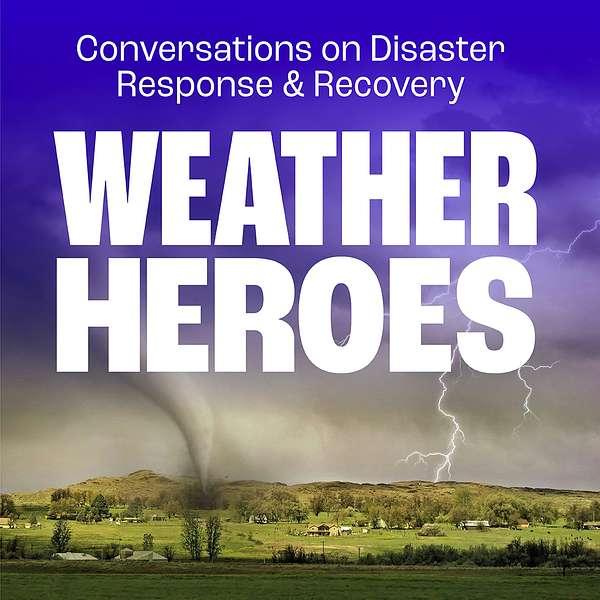
Weather Heroes
Weather Heroes takes you on an insightful journey into the essential realm of disaster preparedness and response. We introduce you to key weather experts from diverse backgrounds and industries, shedding light on their vital roles before and after extreme weather events.
The financial, environmental, and human costs of weather disasters are staggering. In 2023 alone, the National Oceanic and Atmospheric Administration (NOAA) reported 28 weather disasters, causing at least $92.9 billion in damage. This record-breaking year surpassed the previous high of 22 events in 2020. Since 1980, the U.S. has endured 376 major weather events, accumulating over $2.5 trillion in damages.
With the total damage estimate from 2024, including the L.A. Wildfire and the third costliest hurricane season (featuring Hurricane Helene), the overall cost will undoubtedly rise. Moreover, countless smaller-scale disasters also leave profound impacts on people's lives and properties.
Each weather event unfolds its own narrative, uniquely affecting individuals and communities. Weather Heroes connects you with those who rebuild lives—sharing stories of resilience and unwavering dedication.
Weather Heroes
Can You Hear Me Now?
In 1983, the DynaTAC 8000X cellular telephone, affectionately known as “the brick,” entered the market. Those of us of a certain age, certainly remember it! Since then, cell phones have seamlessly woven themselves into our daily lives. These pocket-sized devices grant us access to seemingly endless information and provide countless ways to communicate with family, friends, and the world at large. In fact, many individuals have abandoned their landlines altogether, relying solely on their cell phones.
When disaster strikes, a cell phone can transform into a virtual lifeline. Cellular communication can become critical for everyone impacted by a catastrophe, including first responders, survivors, and concerned loved ones. But what happens when this essential technology faces challenges?
Communication infrastructure is often among the first casualties of natural disasters. Standard cell towers, and even landline networks, are susceptible to damage, leading to disruptions in telephone service, internet access, and potentially satellite-based communication devices. When citizens require rescue or urgent medical attention, effective communication becomes a matter of life and death. The inability to use a cell phone for its intended purpose can be both frustrating and unsafe. As days pass without cell service restoration, the challenges and frustrations mount.
We have ample evidence of these disruptions.
Hurricanes are generally the most common peril to create wide-spread impacts to cell service. Some notable examples include:
· Hurricane Katrina struck in 2005 and the Federal Communications Commission (FCC) tallied more than one thousand cell sites lost. Weeks after the hurricane made landfall, there were still 350,000 people without phone service and three 911 call centers.
· When Hurricane Harvey hit Texas in 2017, flooding took out 70 percent of the cell service.
· When Hurricane Michael hit Florida in 2018, about 70% of wireless sites were still not operational one week later due to wind damage.
· And in 2021 Hurricane Ida damaged 28 percent of the cell sites.
The Northridge earthquake of 1994 in Los Angeles remains a significant event in California’s seismic history. Back then, most of the general public didn’t own cell phones, and the internet was not as ubiquitous as it is today. However, more recent earthquakes provide valuable insights into how profoundly the next tremor could affect mobile services in the U.S. These incidents highlight the vulnerability of communication networks during seismic events.
1. A magnitude 6.3 earthquake struck Christchurch, New Zealand in 2011, and cell service was disrupted for approximately five days.
2. In 2008, Sichuan, China had a magnitude 7.9 earthquake which caused over 2,300 cell phone towers to collapse. Cell service outages persisted for weeks. American officials took note of this experience because China’s cell tower building standards closely resemble those in the United States.
At the height of California’s historic 2019 wildfire season 874 towers were down, primarily due to power challenges, but 60 had damage related to wind and fire. After the Maui wildfire, the Federal Communications Commission reported 20 of the 21 cell sites serving West Maui were down, some for an extended time.
Questions or comments: weatherheroesrock@gmail.com
Mobile Cellular Recovery Vehicle Acronyms
- Cells on Wheels (COWs)
- Cells on Light Trucks (COLTS)
- HVACs on Roadside Equipment (HORSEs)